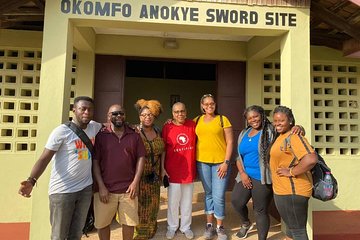One day tour at Kumasi
Share this tour

Offered languages
- German
- English
Tour like a local and experience the culture and the tradition of the Asante Kingdom, the heartbeat of Ghana.
What's Included
Meeting and pickup
Infront of the Museum
At the Kejetia market
Itinerary
-
1Manhyia Palace Museum
One most important attraction to the palace that adds to the rich experience of tourists is the Manhyia Palace Museum. This Museum, although small in size, holds numerous and historic artefacts, war amulets and others of the Asante Kingdom. The palace was opened in 1995 during the Silver Jubilee celebration of the accession of the Golden Stool.
45 minutes • Admission ticket included -
2Kumasi Fort - Ghana Armed Forces Museum
The museum features military equipments, artifacts and other items used during the British Asante war of 1990 as well as the 2nd World War. Other collections include war weapons, colors, medals, armored cars, portraits and photographs. This is a source of valuable historical building for referring back to the evolution and development of Ghana under colonial era till the present day
1 hour • Admission ticket included -
3Prempeh II Museum
This museum may be small but the personalised tour included with admission is a fascinating introduction to Ashanti culture and history. Among the displays are artefacts relating to the Ashanti king Prempeh II, including the king's war attire, ceremonial clothing, jewellery, protective amulets, personal equipment for bathing and dining, furniture, royal insignia and some fine brass weights for weighing gold. Constructed to resemble an Ashanti chief's house, it has a courtyard in front and walls adorned with traditional carved symbols.
25 minutes • Admission ticket included -
4Okomfo Anokye Sword Site
Encased within its own small museum, the Komfo Anokye Sword Site is the spot where the the 'immovable' Sword driven into the ground by Okomfo Anokye sits.
15 minutes • Admission ticket included -
5Ntonso Adinkra Craftsmen
Ntonso Adinkra Cloth Village. Ntonso is the homeland of adinkra cloth and the only place in Ghana where traditional adinkra is made locally from scratch. Ntonso is still Ghana's biggest producer of adinkra, a cloth famed for its symbols and proverbial wisdom
50 minutes • Admission ticket included -
6
Kente cloth is a legendary fabric worn by African kings down the centuries. The cloth is still made in the traditional way in Adanwomse in the Ashanti region of Ghana. Kente is worn not only for its eye- catching designs but also for its symbolic significance. There are over 300 patterns, each with its own name and meaning derived from proverbs, historical events, important chiefs and valuable plants.
1 hour • Admission ticket free -
7Kejetia Market
The Kumasi Central Market is an open-air market in the city of Kumasi, the capital of Ashanti. Kumasi Central Market is in the rain forest bioregion of Ashanti on the Ashantiland Peninsula
1 hour • Admission ticket not included
Additional info
- Wheelchair accessible
- Service animals allowed
- Public transportation options are available nearby
- Infants are required to sit on an adult’s lap
- Specialized infant seats are available
- Suitable for all physical fitness levels
Tags
Cancellation Policy
For a full refund, cancel at least 24 hours before the scheduled departure time.
Show more
Cancellation Policy
- For a full refund, you must cancel at least 24 hours before the experience’s start time.
- If you cancel less than 24 hours before the experience’s start time, the amount you paid will not be refunded.
- Any changes made less than 24 hours before the experience’s start time will not be accepted.
- This experience requires good weather. If it’s canceled due to poor weather, you’ll be offered a different date or a full refund.
Rating
You can cancel up to 24 hours in advance of the experience for a full refund.
Your guide to the flawless travel experience






